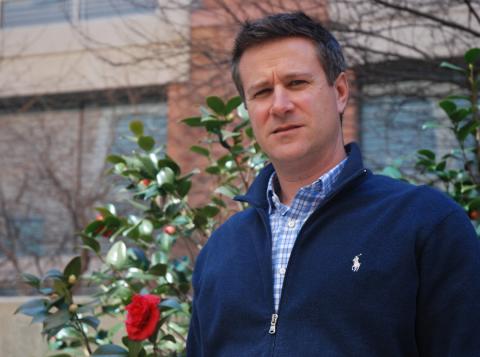New Landscape Architect Brings Unique Skills to NIH

Photo: By Eric Bock
Brandon Hartz envisions a campus teeming with native wildlife. That’s why he went to a large meadow near the Bldg. 31 parking lot and planted milkweed seeds on a recent sunny day.
He bought the seeds with his own money and started them in his refrigerator—a process called cold stratification—to simulate a damp winter. If it grows, the milkweed will attract monarch butterflies and other beneficial pollinator insects. Eventually, Hartz hopes the native plants will establish themselves and provide competition to invasive plants and attract birds and other animals.
“It’s a big experiment. For me, it’s very exciting,” said Hartz, the new landscape architect with the Office of Research Facilities.
Such extracurricular ambition augurs well for a man who is succeeding legends—his immediate predecessor, Lynn Mueller, served with distinction for nearly 37 years. Before him, Tom Cook, who retired in 1991, spent 31 years on NIH’s grounds staff.
If all goes as planned, the increase in plantings will help reduce the use of herbicides on campus, improve air quality and cleanse parking lot runoff before it eventually flows into the Potomac River, the region’s primary drinking water supply. The meadow near the 31 parking lot is just one of six areas around campus, including the Stoney Creek Pond near NLM, where Hartz and a group of volunteers are reintroducing several types of native plants.
As landscape architect, he directs the grounds maintenance contractor’s basic maintenance, such as turf renovation and pruning trees, works with ORF’s Division of Environmental Protection to address water runoff issues and digitally catalogs just about every tree on campus—roughly 8,500 of them. He also sits on an architectural design review board with other employees from ORF. In late April, he will lead tours of the NIH stream on Take Your Child to Work Day.
Prior to joining NIH, Hartz spent 12 years working for private design and architecture firms after receiving his master’s degree in landscape architecture from Harvard University.
He worked on projects for the Department of State, the FBI, U.S. Coast Guard and the National Park Service. He was lead landscape architectural designer for teams that built the third-largest green roof in the United States and restored the National Mall’s lawn. He’s also helped design sites for several office buildings in Washington, D.C., where “every sustainable strategy had to be considered” before construction started.
At NIH, he’ll get to know the campus and its seasonal changes, something he’s never had the opportunity to do. In his previous jobs, “I’d work at a site and move on.”
He takes over as landscape architect from Mueller, who retired at the end of 2015. “Everyone tells me I have big shoes to fill,” Hartz noted. “They are right. Lynn cared deeply about the environment and the people here.”
Since he began the job last June, Hartz has been reviewing a file cabinet full of Mueller’s notes and walking around campus. He knows he can’t replace Mueller, but he believes his experience in sustainable design will help him meet the needs of a changing campus and climate.
Before he designs any project, Hartz thinks about the safety of staff, patients and visitors. He tries to anticipate future problems during the design process. For example, he won’t plant trees if he thinks they will encroach on sidewalks or roads. Safety takes priority over aesthetics.
“Every decision is in some way guided by whether I am helping to create a safer environment for everyone here at NIH,” he said.
Being a landscape architect at NIH isn’t as simple as deciding where to plant trees, grass or shrubs. “There are a lot of constraints here,” Hartz noted.
Every time a tree is felled, another tree must be planted in its place. He helps decide the species and where the tree will be located—whether it’s in a forested area or a high-visibility area. He tries to strategically plant trees so they provide shade when staff, patients and visitors walk across campus.
Hartz must also contend with the campus deer herd. The deer eat new plant growth and bucks rub their antlers on trees, stripping away bark on trunks. Some plants such as rhododendrons “are like candy” to deer. Species prone to deer damage are no longer planted.
Additionally, there is no irrigation system on campus, so every plant must be able to withstand a drought. Every time it snows, groundskeepers put down salt on the roads and sidewalks. That salt washes away onto grass and flowerbeds. As a result, plants near roads and sidewalks must tolerate runoff salt.
One of the projects currently occupying Hartz is the green roof that will be built on top of the Northwest Child Care Center. Once finished, the roof will be visible from the Clinical Center’s upper floors.
In the future, he wants to increase flora and fauna biodiversity. If there’s enough variety, a disease or pest outbreak won’t “kill a majority of plants on campus.”
Hartz says he wants to make campus as comfortable as possible for those inhabiting it, for it is full of “hidden treasures that people don’t get to see.”
